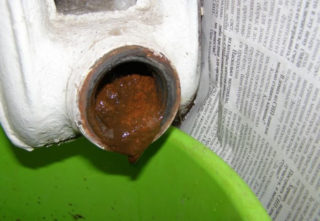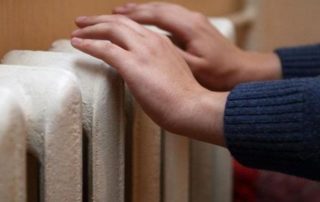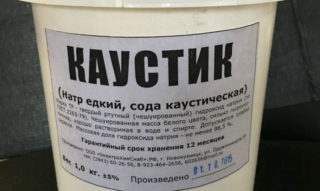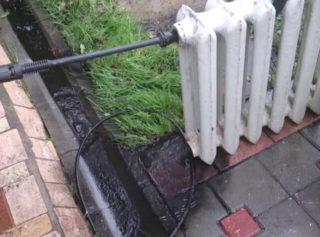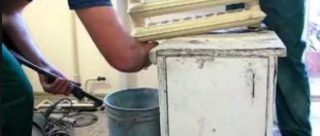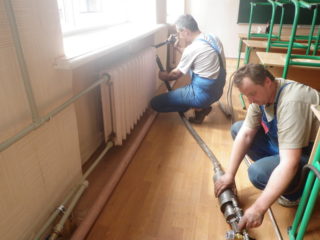Rinsing of cast-iron batteries is necessary to eliminate blockages and carry out preventive measures in order to maintain normal indoor temperature in the winter, and prevent product damage. The cleaning procedure is not particularly difficult, subject to certain conditions, it can be carried out independently at home without the involvement of specialists.
Why do I need battery flushing?
Cast iron radiators are characterized by a rather long service life, but even the correct installation and operation does not protect them from the gradual accumulation of various contaminants:
- rust;
- scale (calcium);
- organic suspension;
- chemical residues;
- another sediment.
As pollution accumulates, the throughput of the system is reduced, which negatively affects the efficiency of its operation. In such cases, an alternative to replacing old heat exchangers is to clean them from the inside.
1 mm thick dirt reduces the efficiency of the heating system by 15%. To avoid problems, it is recommended to prophylactically flush the radiators at least once a year before or after the heating season.
Clean batteries from dust and dirt on a weekly basis. Such a need is caused not only by aesthetics and hygiene, but also by an improvement in heat transfer by the system.
Signs of obstruction
The fact that the radiator is clogged can be determined by the following signs:
- tactile examination shows uneven heating of the battery;
- neighbors have a higher temperature in the apartment;
- warming up the heating system longer than in previous periods;
- the temperature in the risers and outlet pipes significantly exceeds the indicators in the heat exchanger;
- the presence of extraneous sounds in the heating system.
In a private house there is an increase in energy for heating while reducing heat transfer.
If you do not rinse the cast-iron radiators, the temperature in the room will drop every year at constant costs of maintaining it.
How to clean cast iron radiators
Battery cleaning can be carried out mechanically without the use of special tools. Simple tapping of each section leads to the separation of scale from the inner surface, then debris is removed by water under pressure. The technique is doubtful, quite rigid, can lead to damage to the product.
A good result is achieved using chemical or complex methods using:
- alkalis;
- citric or acetic acids;
- whey;
- caustic soda;
- means for cleaning sewer pipes, for example, “Mole”;
- solution for washing car radiators.
The cleaning procedure is quite time-consuming, so it is better to use special solutions, the action of which is most effective.
The complex method consists in the combined use of a chemical agent and a mechanical method (tapping).
Preparatory work
It is advisable to flush radiators on the street. If this is not possible, before cleaning the cast iron batteries inside, it is necessary to prepare the room in which the work will be carried out.You should remove the curtains, remove things and furniture to reduce the risk of contamination, lay a rag on the floor, and hang the walls.
Directly cover the bath with a rag to prevent damage to the enamel layer, close the drain with a special mesh to avoid debris particles clogging it.
Next, the heating system is turned off and the coolant is drained. Individual heating involves shutting down the heating unit and removing water from the system. There are several ways, depending on the type of boiler and the drainage options provided.
Stopping the supply of water to the radiator in multi-apartment buildings is possible when closing valves. Previously, you should get advice from specialists in the housing office.
Dismantling the battery involves disconnecting it from the heating system, removing and draining the water present in it into a previously prepared container.
How to flush
After disconnecting, the battery is transferred to the street or placed in a bath or other container and filled with hot water. To do this, you can use a hose, shower, watering can, kettle or funnel. Both plugs must be open for the free flow of dirty liquid. Periodically, the radiator must be shaken, pour out the contents and remove dirt with hands, wire, brush. Actions are repeated until large pieces of dirt appear. Cast iron products are very heavy, so you should find helpers.
Next, the plugs are closed on the radiator, a cleaning agent diluted in water is poured into it for 1-2 hours.
It is necessary to thoroughly clean the battery from the cleaning agent with a strong pressure of water until there is no foam at the outlet and no characteristic odor. With poor washing, part of the chemical solution remains inside the device, which leads to the destruction of the metal and leaks.
After the procedure, the radiator is installed in its original place.
The use of a pneumatic gun or other special devices designed to eliminate pollution is not ruled out.
Safety precautions must not be neglected. All actions must be carried out with rubber gloves so that the chemical solution does not get on the skin.
Is it possible to clean the radiator without dismantling
You can wash the radiator without dismantling in a private house by cleaning the entire line. It is necessary to block the steam line and let the water flow along the thermal circuit until a clean liquid appears at the outlet.
Washing the batteries in an apartment building without dismantling them is possible only by agreement with the other tenants and is carried out by utilities using the hydropneumatic method. Air-saturated water is supplied to the system. Shocks of micro bubbles on the inner surface of the radiators lead to leaching of contaminants.
It is better to turn to the help of professionals who qualitatively and accurately carry out all the necessary actions.
